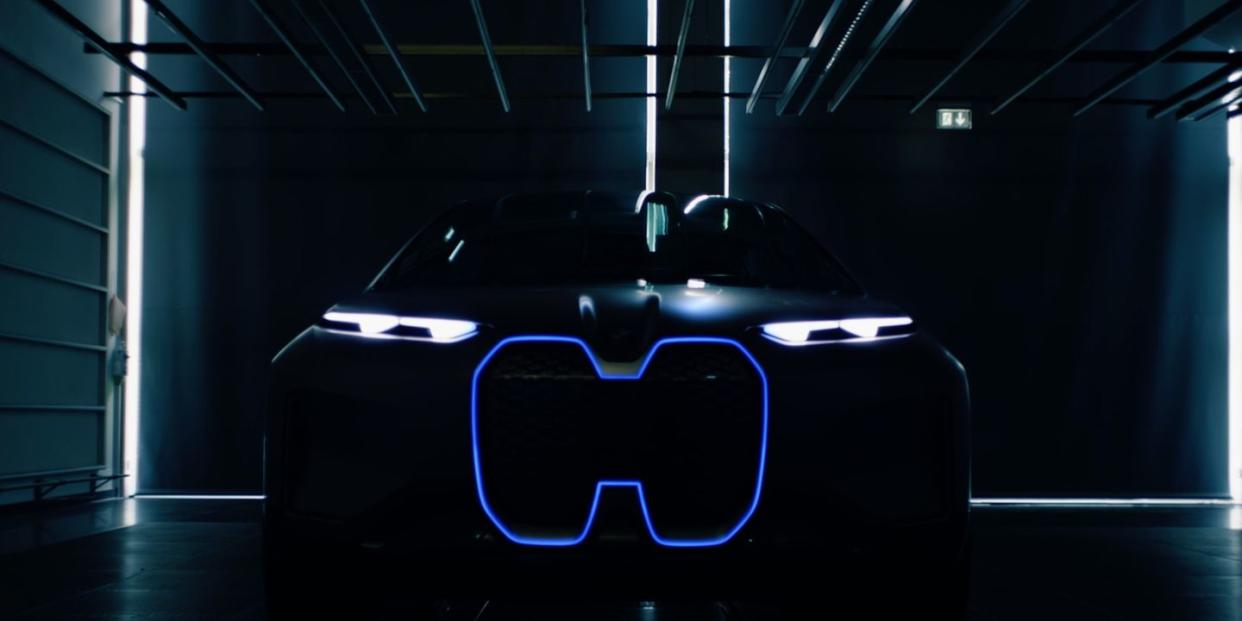The BMW Vision iNext Is Autonomous and Frighteningly Intelligent

Amid a clutter of autonomous concepts promising an electrified, accident-free ride with voice assistants and screens as our companions, BMW's latest Vision concept performs as expected. Absurdly large 24-inch wheels and suicide doors? Check. A lounge-style cabin where passengers roam about without the burden of buckling up? Got it. Seat fabric you caress with your fingertips to play a song? Now we're onto something new.
The Vision iNext employs what BMW calls "shy tech," which means hiding the impressive technology but keeping it all within reach. Beneath the rear bench with its 1960s-style green upholstery, which resembles Don Draper's office furniture, is a matrix of sensors and fiber optics that respond to touch, handwriting, or anything BMW thinks you'll want to trace onto a seat. Doodle a music note with your pinky, and the pattern illuminates through the fabric; the car might then play Bon Jovi. Swipe with a few fingers to crank up “It's My Life,” that classic hit that BMW passengers in the previous century had to buy in a store. The driver or passenger can operate the twin displays sticking out of the dash by rubbing the herringbone wood on the center console as if it were a touchpad. Or anyone can say, “Hey, BMW,” and talk to the car's voice-activated concierge, which was out of the office when BMW executives tried to demonstrate it during the car's debut in New York. That brand-new feature, known as Intelligent Personal Assistant, joins BMW's existing Gesture Control, which (sometimes) responds to midair finger jabs to control stereo and phone-call tasks.
BMW also demonstrated Intelligent Beam, a miniature video projector with motion sensing, by flipping through the pages of a blank book. As video and images filled the pages to their edges, we watched a BMW designer pinch and zoom with his fingers and then flip the page for new content. Imagine a printed magazine like Car and Driver animating in your hands. Imagine reading this article without peering into a backlit screen.
There are other technologies-for instance, the steering wheel and pedals collapse when you press the BMW roundel-that aren't as eye-popping as the mechanized dashboard in BMW's Vision Next 100 concept from 2016. But physical details, including bucket seats with headrests that bend backward, the illuminated crystal in the center console, and the exposed carbon-fiber sill, are at least eye candy.
Outside, the Vision iNext resembles a compact crossover with the bonus of the most elongated snout BMW has made since the 303 of 1933, its first car with the now iconic twin kidneys. Behind the elaborate texture of these modern kidneys are all manner of self-driving sensors. The squinting LEDs pay the least homage to BMW's traditional quad headlights, but if you start squinting, you'll swear the copper paint surrounding them is changing colors. That's no illusion, as the roof and rear quarters actually blend into a rose gold toward the curved tailgate and the illuminated diffuser beneath it.
When prodded about the iNext's performance, BMW R&D chief Klaus Fröhlich said it would be capable of 373 miles of range, could reach 60 mph in less than four seconds, and would be the best in its class. After all, Fröhlich pointed out, it is a BMW. The company says a real car based on this concept will arrive in 2021, with whatever autonomous features it can legally use by that time. It's certainly not the sleek, fender-flexing sedan that the Next 100 concept was. But if the only thing that transfers to production is X3 owners rubbing their seats while saying “Hey, BMW,” then the iNext may have fulfilled its destiny.
('You Might Also Like',)

